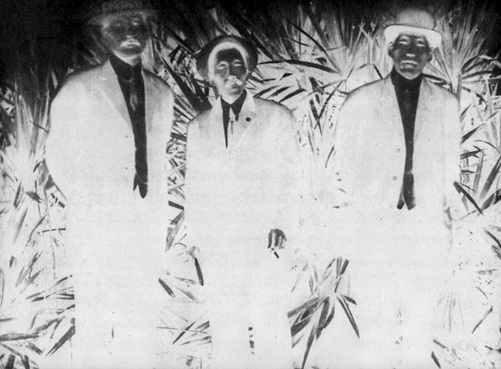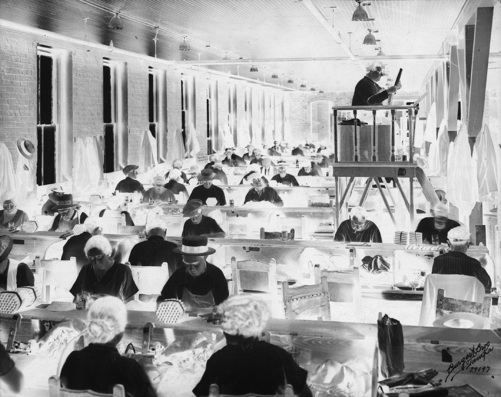The History of Florida (99 page)
Read The History of Florida Online
Authors: Michael Gannon
Tags: #History, #United States, #State & Local, #Americas

concluded in 1865 that a majority of citizens believed “negroes will not work
on the plantations in a manner that will pay for the necessary investment of
capital.”2 Thus, to solve the state’s labor problem, anxious Floridians sought
to divert to their state a portion of the rising tide of European immigration
then flowing into the United States. For a few decades after 1868, Florida’s
official Bureau of Immigration promoted the state and its favorable pros-
pects to prospective immigrants, but it was notably ineffective.
More energetic and effective immigration activities emanated from pri-
vate interests. During the late nineteenth century, railroads, farm groups,
real estate companies, wealthy landowners, mine operators, and industri-
alists directed an impressive volume of literature about Florida to distant
parts of the globe. Italian immigrants received special attention in these
campaigns. The prevalent perception of Florida as the “Italy of the South”
and the common view that Italians excelled in citrus horticulture com-
bined to make them appear particularly desirable. In 1873, citrus developer
Immigration and Ethnicity in Florida History · 473
Henry S. Sanford explained that Italians were “a most valuable class of im-
migrants . . . intel igent and industrious, accustomed to orange and vine
culture, and to a warm climate.”3 A similar enthusiasm for Chinese workers
swept the state in these years, based on reports of their industriousness and
skil in gardening. Nevertheless, promotional efforts attracted only insignifi-
cant numbers of Italians and Chinese. When Florida turned away from sup-
porting immigration by the first decades of the twentieth century, these two
groups ironical y came to be regarded as the least acceptable newcomers.
The drive to acquire foreign immigrants col apsed for several reasons.
Since many Floridians supported foreign immigration as a means of re-
placing black workers, they assumed that new arrivals would be content
merely to change positions with the former slaves. Unsatisfactory crop lien
and sharecropping arrangements characterized the fate of many early immi-
grants who worked in Florida agriculture. Even worse, peonage exploitation
was a common circumstance in turpentine camps, lumbering operations,
and railroad construction projects. News of these conditions quickly spread
outward and considerably dampened enthusiasm for Florida among poten-
tial immigrants.
The attitudes of Floridians themselves similarly underwent a transfor-
mation. Slowly in the 1890s and then with increasing speed after 1900, the
proof
state’s earlier policy of open welcome turned to hostility toward foreign
settlement. Florida had become engulfed in the rising tide of nativist senti-
ment sweeping the nation. Concerns over the effects of introducing foreign
religions, alien political ideologies, and potential y disturbing new racial
strains rose to the surface. By 1910, most Floridians believed that if the state
were to retain its racial integrity, preserve its unique “American” charac-
ter, and protect is cherished institutions, it now had no room for foreign
immigrants.
Even during the turn against immigration, however, a variety of promot-
ers pursued colonizing plans. Immigrant colonies appealed to some land-
owners and financiers on several grounds. This mode of settlement disposed
of large tracts of land in one transaction and enhanced the value of adjacent
property substantial y. Moreover, this tactic seemed to offer the best pros-
pects of permanent residence, since newcomers settled as a group could
more easily perpetuate familiar customs and ease the difficult transition to
life in the new land.
Florida’s record of modern colony settlement included both success
and abject failure. One effort to bring fifty Scottish settlers to Sarasota in
1885 foundered when the new arrivals found not the thriving community

474 · Raymond A. Mohl and George E. Pozzetta
In 1913, three members of the Japanese colony of Yamato near present-day Boca Raton
posed for the camera outside what had once been their prosperous pineapple plan-
tation. A blight destroyed the crop in 1908, and, owing to cheaper, earlier-maturing
proof
rail-transported pineapple exports from Cuba, the plantation never recovered. Cour-
tesy of the State Archives of Florida,
Florida Memory
, http://floridamemory.com/items/
show/12149.
promised to them but rather a “swampy wilderness” and a few scattered
buildings. They soon abandoned their plans for a new life on Florida’s tropi-
cal frontier. Similarly, in 1893 approximately 500 Danes purchased land at
White City in St. Lucie County, only to learn shortly after arriving that their
on-site manager had died and the group’s financial agent had both sold
them land he did not own and absconded with their money. This venture,
however, was rescued at the last moment by the Florida East Coast Railway
(FECR), which provided emergency supplies and financial backing.
It was no accident that the railroad was on hand to assist. The company
owned vast tracts of land and supported a very active immigration bureau
for many years. The settlement of Dania by Danish immigrants in 1898 grew
out FECR operations, as did a l904 venture to establish a Japanese colony
cal ed Yamato near the present-day location of Boca Raton. In the case of the
Japanese, several years of successful pineapple farming raised expectations
of a large-scale movement of people. By 1907 the FECR had established a
Immigration and Ethnicity in Florida History · 475
rail station at Yamato, and several hundred industrious immigrants worked
the land. A devastating attack of pineapple blight in 1908 ruined the colony’s
hopes, however, and most settlers eventual y returned to Japan disil usioned
with Florida’s prospects.
As promoters and state officials vacil ated over the wisdom of attempting
to attract foreigners, immigrants themselves were often pursuing strategies
of their own and independently creating centers of foreign settlement. The
movement of Greeks to Tarpon Springs, for example, was guided by the
business enterprise and vision of John Cocoris, a Greek immigrant who
saw rich possibilities in the Florida sponge industry. Some Greek spong-
ers had worked in Key West during the 1890s, using the “hook” method of
harvesting from boats. But when huge sponge beds were found in the Gulf
of Mexico off the coast of Tarpon Springs, Cocoris recognized that the tradi-
tional Greek method of collecting, involving deep-water diving with special
suits, would yield much better results. After initial harvesting successes in
1905, a steady flow of Greek immigrants came directly to Tarpon Springs,
eventual y dominating by force of numbers the small community’s institu-
tions and culture.
Two instances of large-scale migration during this period resulted in the
creation of dense urban settlements capable of sustaining a ful range of
proof
viable ethnic institutions and an enduring immigrant culture. The first of
these emerged in Key West during and after Cuba’s so-called Ten Years War
of the 1860s. Expatriate Cuban and Spanish cigar workers and manufactur-
ers flowed into Key West and established a major cigar-making center, while
also turning the small island community for a time into Florida’s largest city.
By the 1870s, some 5,000 exiles labored in Key West’s cigar factories, orga-
nizing effective labor unions and community institutions. Key West was
quickly eclipsed, however, by a cigar-making rival located to the north in
Tampa.
During the years 1885–1924, thousands of Cubans, Italians, and Span-
iards came to the small coastal vil age of Tampa and transformed it into a
thriving industrial center. Drawn primarily to the cigar industry established
in Tampa by Spanish industrialist V. M. Martinez Ybor, the immigrants—
many moving from Key West—quickly made the city into the nation’s lead-
ing center for the production of high-quality, hand-rol ed cigars. Settling
in what was initial y the separate community of Ybor City, the “Latins”
of Tampa created a rich associational life that included immigrant labor
unions, foreign-language newspapers, ethnic fraternal clubs, radical politi-
cal organizations, and a thriving immigrant theater.

476 · Raymond A. Mohl and George E. Pozzetta
Cubans, Spaniards, and Italians came to West Tampa and Ybor City, east of Tampa, to
work in the hand-rolled cigar industry. At the Cuesta Rey factory in West Tampa in 1929,
proof
these men and women silently rolled coronas, perfectos, and panatelas while
el
lector
(the reader) on a raised platform (
right
) read to them in Spanish from newspapers,
novels, and political tracts. Photo by Burgert Brothers. Courtesy of the State Archives
of Florida,
Florida Memory
, http://floridamemory.com/items/show/27163.
No inquiry into the impact of immigrants on Florida during these years
would be complete without recognition of the role played by transient for-
eign workers. Isolated work gangs of Italians, Greeks, Chinese, Portuguese,
Spaniards, and many others crisscrossed the state laboring in plantation
fields, drainage operations, and construction sites. The FECR, for example,
regularly recruited work crews from far afield in its construction projects,
hiring immigrant workers through labor agents located in major northeast-
ern cities. In other economic sectors, such as sugarcane, citrus, and win-
ter vegetables, the seasonal influx of migrant workers from the Bahamas
and other locations became a long-term economic strategy that annual y
brought foreigners into Florida well into the twentieth century.
Black immigrants from the Bahamas added to the ethnic and racial di-
versity of nineteenth-century Florida. Black and white Bahamians had al-
ready established a distinctive presence in Key West by the mid-nineteenth
Immigration and Ethnicity in Florida History · 477
century. Bahamian fishermen, shipwreck salvagers, and Indian traders, ac-
cording to one Bahamian newspaper, regarded Florida “much as another
island of the Bahamas.”4 Facing meager economic prospects at home, Ba-
hamian blacks especial y found better employment opportunities in the
Florida island city. By the 1890s, Bahamians made up about a third of the
population in Key West, where they worked primarily in sponging, turtling,
and fishing. A large majority of today’s Key West blacks trace their ancestry
to Bahamian origins.
The black Bahamian migration to Florida intensified after the establish-
ment of Miami in 1896. Like most other Caribbean islanders, Bahamians
pursued a “livelihood migration” involving temporary labor elsewhere and
regular return to the home island. The building up of Miami at the turn of
the century created new opportunities for Bahamian migrant workers, who
were attracted to the city by the prospect of better jobs and higher wages.
As one Bahamian migrant remembered it, perhaps overstating the situation,
“Miami was a young Magic City where money could be ‘shaken from trees.’”5
Bahamians who returned to the islands enticed others to follow with exag-
